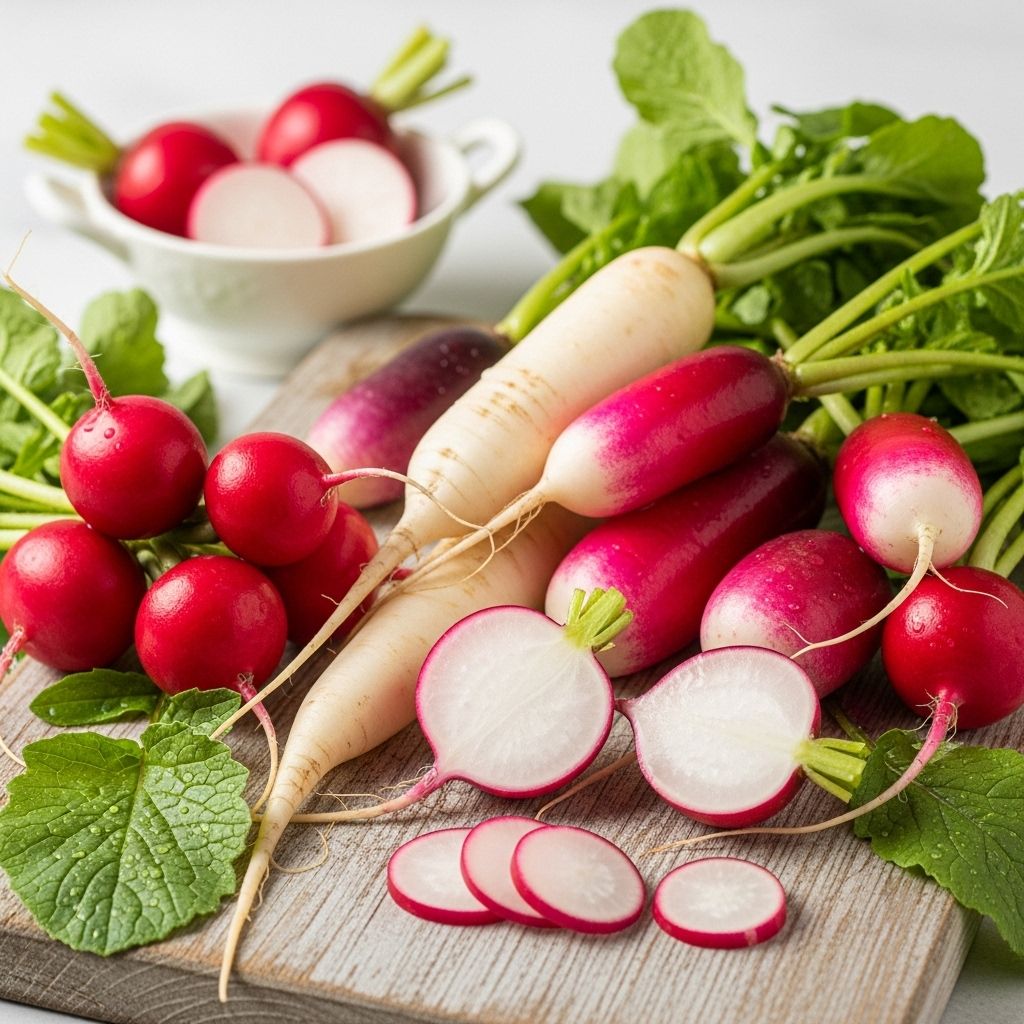13 Incredible Health Benefits of Radish: Nutrition, Uses & Side Effects
A peppery crunch that boosts hydration, supports digestion, and enriches everyday dishes.

Radish: Nutrition, Uses, Benefits, and More
Radishes, known for their crisp texture and peppery flavor, are not just a salad staple but a powerhouse of nutrition and health-promoting compounds. Whether consumed raw, pickled, or cooked, radish roots and greens are used worldwide for their refreshing bite and versatile culinary roles. This article comprehensively explores the health benefits, nutritional content, types, medicinal uses, easy recipes, precautions, and frequently asked questions related to radishes.
What Are Radishes?
Radishes are root vegetables belonging to the Brassicaceae family, which also includes cabbage, broccoli, and mustard greens. The most common type is the round, red-skinned radish (Raphanus sativus), but many varieties exist, such as the elongated white daikon or winter radish, black radish, watermelon radish, and more. All radish types share a sharp, peppery flavor that comes from natural compounds known as glucosinolates.
Nutritional Value of Radish
Radishes are valued for being low in calories, high in water, and rich in important micronutrients. Here is an approximate breakdown per one-cup (116g) serving of raw radishes:
| Nutrient | Amount per 1 cup (116g) |
|---|---|
| Calories | 19 |
| Protein | 0.8 g |
| Fat | 0.1 g |
| Carbohydrates | 3.9 g |
| Fiber | 1.9 g |
| Sugar | 2.2 g |
| Vitamin C | 14 mg (about 14% DV) |
| Folate | 30 mcg |
| Potassium | 192 mg |
| Calcium | 29 mg |
| Sodium | 45 mg |
In addition to these, radishes contain smaller amounts of magnesium, phosphorus, vitamin B6, niacin, and riboflavin.
Top 13 Health Benefits of Radish
Radishes offer a surprising number of health-promoting effects, ranging from digestive health to potential cancer-protective properties. Here are 13 top benefits:
1. Packed with Antioxidants
Radishes are an excellent source of antioxidants—including vitamin C, catechins, pyrogallol, vanillic acid, and other phenolic compounds. Antioxidants help protect your body from oxidative stress and free radicals, which can contribute to aging and chronic conditions such as heart disease and cancer.
2. Support Heart Health
Anthocyanins and fiber found in radishes may help reduce cholesterol levels and lower the risk of cardiovascular diseases. They aid in reducing blood pressure and maintaining healthy arteries by fighting inflammation and oxidative damage.
3. Aid Digestion
With a significant fiber content, radishes promote regular bowel movements, prevent constipation, and support overall digestive health. The peppery compounds in radishes may stimulate the production of digestive juices and bile, especially in varieties like black radish, improving fat metabolism and liver detoxification.
4. Help in Blood Sugar Management
By slowing sugar absorption and minimizing starch-induced glycemic load, radishes can help regulate blood sugar levels. Compounds like glucosinolates and isothiocyanates may further support insulin responsiveness and glucose uptake, making radishes beneficial for people with or at risk for diabetes.
5. May Offer Cancer-Protective Effects
Some laboratory studies show that extracts from both radish roots and leaves can inhibit the growth of certain types of cancer cells, likely due to their antioxidant and isothiocyanate content. These compounds help neutralize potential carcinogens and may slow the spread of cancerous cells.
6. Support Liver Function
Radishes, especially black radish, contain compounds like indole-3-carbinol and 4-methylthio-3-butenyl-isothiocyanate which aid in boosting liver enzyme activity and facilitate flushing out toxins from the bloodstream. This can help protect and restore liver function.
7. May Prevent Gallstones
Studies suggest that glucosinolate compounds in radishes may help lower cholesterol levels in the liver, thus reducing the formation of gallstones and supporting healthy bile flow.
8. Possess Antifungal Properties
Radishes, particularly their natural protein RsAFP2, show promise in inhibiting the growth of fungi like Candida albicans, which causes yeast infections in humans.
9. Promote Weight Management
Low in calories, high in fiber, and containing lots of water, radishes make a satiating snack that supports weight loss or maintenance by promoting fullness without excess calories.
10. Strengthen Immunity
The significant vitamin C content in radishes plays a central role in supporting immune function, helping your body resist infections and reducing the duration and severity of common illnesses.
11. Benefit Skin Health
The antioxidants and vitamin C in radishes contribute to healthy skin by supporting collagen production, protecting against UV-induced damage, and promoting faster wound healing.
12. Enhance Hydration
Radishes are composed of over 95% water, which helps keep you hydrated, especially in warmer months. They can be a refreshing, low-sugar way to increase fluid intake and support metabolic functions.
13. Provide Essential Micronutrients
In addition to vitamin C and potassium, radishes also offer small but important amounts of folate, calcium, iron, vitamin B6, and manganese—nutrients vital for energy production, nervous system function, and bone health.
Types of Radish and Their Benefits
Radishes vary widely in shape, size, color, and even taste. The main types include:
- Red Radish: Small, round, peppery, and commonly eaten raw in salads. Contains antioxidants and vitamin C.
- White Radish (Daikon): Larger, milder in taste, often used in Asian cuisine and pickling. Promotes digestive health.
- Black Radish: Pungent, with a tough black skin and white flesh; often used for liver detox and bile stimulation.
- Watermelon Radish: Pale green outside, bright pink inside — visually attractive and mildly sweet, rich in antioxidants.
Traditional Uses of Radish in Medicine
Aside from its culinary appeal, radish has a long history in traditional medicine systems, including Ayurveda and Traditional Chinese Medicine (TCM).
- Ayurveda: Used for balancing digestion, promoting detoxification, and alleviating respiratory congestion.
- Traditional Chinese Medicine: Believed to regulate energy (Qi), clear heat, resolve phlegm, and aid in removal of food stagnation.
Modern research supports some of these effects, especially regarding digestive and liver support.
How to Use Radish
Radish is a versatile vegetable that can be enjoyed in various forms:
- Raw: Slice thinly for salads, slaws, or as a crunchy snack.
- Pickled: Radish pickles (such as takuan in Japanese cuisine) offer probiotics and vibrant flavors.
- Cooked: Add to soups, stir-fries, or roasted with other root vegetables.
- Juiced: Radish juice is suggested in folk medicine for liver and kidney function support.
- Greens: Don’t discard the leaves — radish greens are edible and nutritious, suitable for sautés or adding to pesto.
Easy Radish Recipes to Try
- Radish Salad: Thinly slice radishes, toss with lemon juice, olive oil, salt, and fresh herbs.
- Pickled Radishes: Slice raw radishes and pickle with vinegar, salt, sugar, and your favorite spices.
- Radish Stir-Fry: Sauté radishes and greens in olive oil with garlic and spring onions.
- Stuffed Daikon: Hollow out daikon radish sections, fill with a spiced mixture of tofu or ground meat, and simmer in broth.
Possible Side Effects and Precautions
While radishes are generally considered safe and healthy, excessive consumption may lead to certain issues:
- Digestive Discomfort: Eating large quantities in one sitting could cause bloating or gas due to high fiber content.
- Thyroid Function: Radishes contain goitrogens, compounds that may interfere with thyroid hormone production in susceptible individuals, especially those with underlying thyroid disorders.
- Gallbladder Issues: Those with gallstones should consult a healthcare provider before increasing radish intake due to its impact on bile flow.
Frequently Asked Questions (FAQs)
Q: Are radishes good for weight loss?
A: Yes, radishes are low in calories, high in fiber, and mostly water, making them an excellent snack for those aiming to lose weight and improve satiety.
Q: Can radishes help with diabetes?
A: The fiber and specific plant compounds in radishes may help regulate blood sugar levels by slowing carbohydrate absorption and supporting insulin function. However, they should complement, not replace, standard medical care for diabetes.
Q: Are radish greens edible?
A: Absolutely! Radish leaves are not only edible but rich in antioxidants, calcium, and vitamin C. Cook them lightly to reduce bitterness or add to soups and smoothies.
Q: What is the best way to store radishes?
A: Store unwashed radishes in the refrigerator, ideally in a perforated plastic bag to retain moisture and crispness. Separate greens from the root for best shelf life.
Q: Can people with thyroid problems eat radishes?
A: In moderate amounts, radishes are safe for most people. However, those with thyroid issues should consult their healthcare provider before consuming large amounts due to the goitrogen content.
Summary
Radishes are a crunchy, peppery, and versatile root vegetable packed with vitamins, minerals, and unique phytochemicals that promote health in many ways. They offer antioxidant, digestive, metabolic, immune, and skin benefits, feature prominently in both culinary traditions and traditional medicine, and are simple to incorporate into everyday meals. While generally safe, moderation is key, especially for those with thyroid or gallbladder conditions.
References
- https://www.bbcgoodfood.com/health/nutrition/top-5-health-benefits-of-radishes
- https://cdn.agclassroom.org/media/uploads/LP875/radish_nutrition_facts.pdf
- https://www.webmd.com/diet/health-benefits-radish
- https://www.healthline.com/health/food-nutrition/the-benefits-of-radishes
- https://www.mayoclinichealthsystem.org/hometown-health/speaking-of-health/radishes-big-flavor-in-a-small-package
- https://www.signos.com/foods/radish-glycemic-index
Read full bio of Sneha Tete









